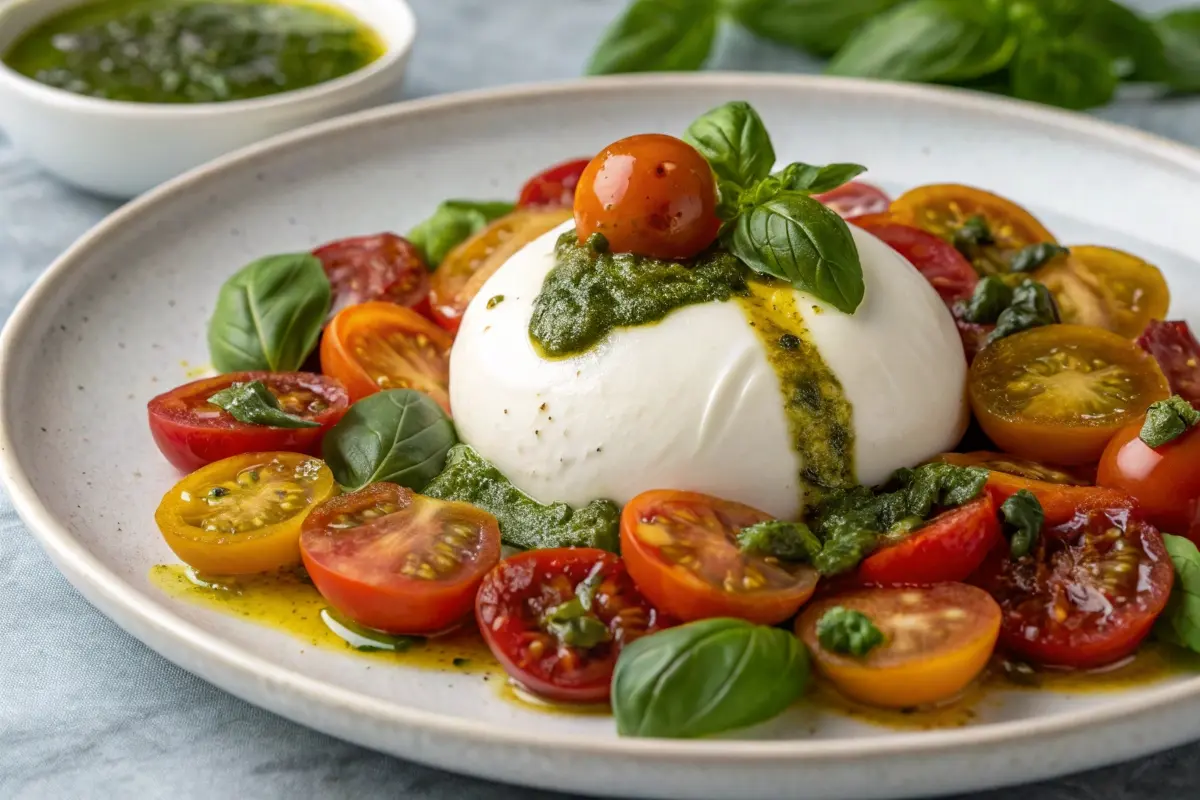Burrata is more than just a cheese—it’s a culinary masterpiece. Its name comes from the Italian word burro, meaning butter, hinting at its rich and creamy texture. Originating in the southern Italian region of Apulia, Creamy Italian cheese has become a staple in gourmet kitchens worldwide. But what makes it so unique? At its heart, Creamy Italian cheese combines the best of mozzarella and cream to create a flavor and texture unlike any other cheese.

This fresh cheese is crafted with care and precision, offering a delicate outer shell of mozzarella that encases a creamy filling made of stracciatella (shredded mozzarella soaked in cream). It’s no wonder that Italian cheese delicacy has gained such a reputation for luxury and indulgence.
The Origins and History of an Italian Cheese Classic
Burrata’s story begins in the early 20th century in the humble dairies of Apulia, Italy. During times of surplus milk, resourceful cheesemakers invented Creamy Italian cheese as a way to use leftover mozzarella curds and cream. It quickly became a beloved regional specialty, prized for its rich, buttery flavor.
Over time, burrata made its way from the farms of southern Italy to fine dining tables across the globe. Today, it’s celebrated not only for its taste but also for its craftsmanship. Eating Creamy Italian cheese is akin to experiencing a slice of Italian history.
Crafting Creamy Delights: How This Cheese Is Made
Making Creamy Italian cheese is an art, a delicate balance of skill and timing. The process begins with mozzarella curd, which is heated and stretched to form a pliable dough. This outer layer is molded into a pouch—a shell that’s soft yet firm enough to hold its creamy interior.
The pouch is then filled with a mixture of stracciatella and cream, which gives Creamy Italian cheese its signature soft, luscious center. Finally, the pouch is sealed and often dipped in brine to enhance its flavor.
“Burrata is a work of art where simplicity meets sophistication. Every bite tells a story of Italian tradition.”
Traditional vs. Modern Techniques in Cheesemaking
While traditional burrata is handmade, modern production has adapted to meet global demand. Artisanal cheesemakers continue to craft Creamy Italian cheese by hand, ensuring each cheese is a labor of love. Industrial methods, on the other hand, rely on machines to replicate the process, which can sometimes compromise quality.
If you’re lucky enough to try freshly made Creamy Italian cheese from a small Italian dairy, you’ll notice the difference. The handmade version often has a softer texture and more vibrant flavor compared to mass-produced alternatives.
What Makes This Cheese So Unique?
Burrata isn’t just cheese; it’s a sensory experience. Its outer layer is smooth and elastic, while the inside offers a creamy explosion of flavor. When you cut into Creamy Italian cheese, the cream spills out, inviting you to savor its rich texture.
Exploring Differences Between Popular Cheeses
At first glance, burrata and mozzarella may look similar, but their differences are striking. Mozzarella is firm and uniform, perfect for pizzas and salads. Creamy Italian cheese, on the other hand, is soft and decadent, thanks to its creamy interior.
If mozzarella is the reliable everyday cheese, Creamy Italian cheese is its indulgent cousin—perfect for special occasions.

The Cream-Filled Heart: What Makes Burrata Special
The magic of Creamy Italian cheese lies in its filling. Stracciatella, mixed with fresh cream, creates a velvety texture that melts in your mouth. This filling is what sets Creamy Italian cheese apart, making it a luxurious addition to any dish.
Culinary Inspiration: Pairing Ideas for Creamy Cheeses
Creamy Italian cheese is versatile, lending itself to a variety of dishes. Whether you prefer it as a standalone appetizer or as the star of a gourmet creation, Creamy Italian cheese never disappoints.
Classic Italian Dishes Featuring Burrata
Some classic ways to enjoy Creamy Italian cheese include:
- Drizzling it with olive oil and serving it with fresh tomatoes and basil.
- Using it as a topping for wood-fired pizza.
- Pairing it with prosciutto and a crusty baguette.
Creative Ways to Use Burrata in Recipes
Think beyond tradition! Try adding Creamy Italian cheese to pasta dishes, pairing it with roasted vegetables, or even using it in desserts like cheesecakes for an unexpected twist.
Tips for Serving Burrata Perfectly Every Time
Always serve burrata at room temperature to fully enjoy its flavor and texture. Cut it carefully to let the creamy center spill out, creating a visual and culinary treat.
Where to Find the Freshest Cheese for Your Table
Finding high-quality burrata is essential to fully appreciate its flavor and texture. Whether you’re shopping locally or online, knowing where to buy this creamy delicacy can make all the difference.
Recognizing High-Quality Burrata
When buying burrata, look for freshness. High-quality Creamy Italian cheese should have a smooth, shiny outer layer of mozzarella with no cracks or discoloration. The inside should be creamy but not runny, and its aroma should be clean and milky—not sour.
You might be tempted to grab the first package you see at the grocery store, but be sure to check the label for its origin. Authentic Creamy Italian cheese from Italy often has a Protected Geographical Indication (PGI) mark, ensuring it’s made with traditional methods.
Online vs. Local Purchases: Pros and Cons
Buying burrata online can be convenient, especially if you’re far from specialty stores. Many retailers ship Creamy Italian cheese in insulated packaging to preserve its freshness. However, the downside is that you can’t inspect the cheese before buying, which can sometimes lead to disappointment.
Local purchases allow you to see the product firsthand and even ask cheesemongers for recommendations. Farmer’s markets or Italian delis are often the best places to find the freshest Creamy Italian cheese.
Proper Storage Tips for Soft Cheeses
Burrata is highly perishable, so proper storage is critical to maintain its quality. Unlike harder cheeses, which can last weeks or months, Creamy Italian cheese has a much shorter shelf life.
How to Store Burrata to Maintain Freshness
Always store burrata in its original liquid, which helps keep the cheese hydrated and flavorful. Keep it in the refrigerator at a temperature of about 4°C (39°F). However, Creamy Italian cheese is best enjoyed as fresh as possible, ideally on the day of purchase.
If you can’t eat it right away, consume it within 48 hours for the best taste. Be sure to avoid freezing Creamy Italian cheese, as this can alter its texture and make the creamy filling lose its smoothness.
Common Mistakes in Storing Burrata and How to Avoid Them
One common mistake is removing Creamy Italian cheese from its liquid too early. This can cause the outer layer to dry out, losing its elasticity and softness. Another mistake is storing it in the coldest part of the fridge, which can cause the cheese to harden. Keep it in a slightly warmer section, like the cheese drawer, for optimal storage.
A Look at the Nutritional Profile of Gourmet Cheeses
Is burrata healthy? Well, it depends on how you define “healthy.” While it’s certainly rich and indulgent, Creamy Italian cheese also offers a range of nutrients that can be part of a balanced diet.
Nutritional Facts About Burrata
Here’s a quick look at the nutritional profile of burrata (per 100g):
| Nutrient | Amount |
|---|---|
| Calories | 300 kcal |
| Protein | 15 g |
| Fat | 25 g |
| Saturated Fat | 16 g |
| Carbohydrates | 2 g |
| Calcium | 200 mg |
While Creamy Italian cheese is high in fat and calories, it’s also a good source of protein and calcium. These nutrients are essential for muscle growth, bone health, and overall wellness.
Burrata in Balanced Diets: Pros and Cons
In moderation, Creamy Italian cheese can be a delightful addition to a healthy lifestyle. Pair it with nutrient-dense foods like leafy greens, tomatoes, and whole-grain bread to create a balanced meal. However, due to its high fat content, it’s best to enjoy Creamy Italian cheese as an occasional treat rather than a daily indulgence.
Common Issues and Solutions for Enjoying Fresh Cheeses
Even with the finest Creamy Italian cheese, things can occasionally go wrong. Here are some common issues and how to address them.
Why Does Burrata Sometimes Taste Sour?
If Creamy Italian cheese tastes sour, it’s often a sign that it’s no longer fresh. Creamy Italian cheese should have a mild, milky flavor. Always check the expiration date before purchasing, and consume it promptly to avoid sourness.
What to Do When Burrata’s Texture Seems Off
Sometimes, Creamy Italian cheese can feel rubbery or too firm. This is usually caused by improper storage or low-quality production. To fix this, allow the cheese to sit at room temperature for 30 minutes before serving—it will soften and taste better.
How This Cheese Has Made Its Mark Globally
While burrata has its roots firmly planted in Italian soil, it has found a place in global cuisine. From fine dining restaurants in Paris to trendy cafes in New York, Creamy Italian cheese is celebrated worldwide.
Burrata in Italian Cuisine vs. Global Adaptations
In Italy, Creamy Italian cheese is often served simply, allowing its creamy flavor to shine. A drizzle of olive oil, a pinch of sea salt, and fresh bread are all it needs. Outside of Italy, chefs experiment with Creamy Italian cheese in innovative ways, incorporating it into everything from sushi rolls to tacos.
Regional Variations of Burrata Cheese
Even within Italy, there are subtle regional variations in how Creamy Italian cheese is made. In Apulia, the traditional recipe uses cow’s milk, while in other regions, goat’s milk may be used. These slight differences can affect the flavor and texture, making each version unique.

Addressing Curiosity: Questions About This Italian Favorite
Can burrata be frozen?
No, freezing Creamy Italian cheeseis not recommended. The freezing process alters its texture, making the creamy interior grainy and less appealing.
What is the best substitute for burrata?
If you can’t find Creamy Italian cheese, fresh mozzarella or cream cheese mixed with mascarpone can mimic its creamy texture and flavor.
How is burrata different from buffalo mozzarella?
Buffalo mozzarella is made specifically from the milk of water buffaloes and has a firmer texture. Creamy Italian cheese, on the other hand, contains a cream-filled center, making it much richer and softer.
Can burrata be eaten raw?
Yes! Creamy Italian cheese is typically served raw to highlight its creamy texture and delicate flavor.
How long can I keep burrata in the fridge?
Creamy Italian cheese should be consumed within 1-2 days of purchase for optimal freshness and flavor.
Is burrata gluten-free?
Yes, Creamy Italian cheese is naturally gluten-free, making it a suitable option for those with gluten sensitivities.
Is burrata the same as mozzarella?
No, Creamy Italian cheese and mozzarella are different. While Creamy Italian cheese is made using mozzarella, it includes a creamy interior of stracciatella and cream, making it richer and softer than traditional mozzarella. Mozzarella, on the other hand, is firmer and more uniform, ideal for cooking and slicing.
Is burrata halal?
Creamy Italian cheese can be halal if it is made using vegetarian or halal-certified rennet instead of animal-derived rennet. It’s best to check the packaging or consult the manufacturer to ensure it meets halal dietary requirements.
Why is burrata so expensive?
Creamy Italian cheese is more expensive than other cheeses because of its labor-intensive production process and short shelf life. The craftsmanship involved in making Creamy Italian cheese, along with its creamy filling and delicate texture, contributes to its premium price.
Do you eat the skin on burrata?
Yes, the outer layer of Creamy Italian cheese is made of mozzarella and is completely edible. The combination of the smooth mozzarella exterior and creamy interior is what makes Creamy Italian cheese so special.
Can burrata be frozen?
No, freezing Creamy Italian cheese is not recommended. Freezing affects the texture of the creamy interior, making it grainy and less enjoyable.
What is the best substitute for burrata?
If Creamy Italian cheese isn’t available, fresh mozzarella or a combination of cream cheese and mascarpone can work as substitutes in recipes.
The Allure of Burrata and Why It’s Worth a Try
Burrata isn’t just a cheese—it’s a symbol of Italian craftsmanship, a treat for the senses, and a versatile addition to your culinary repertoire. Whether enjoyed simply with olive oil and tomatoes or incorporated into a gourmet recipe, Creamy Italian cheese offers a taste experience that’s truly unforgettable.
If you haven’t tried Creamy Italian cheese yet, what are you waiting for? This creamy, dreamy delight is a must for any cheese lover. Go ahead, indulge—you won’t regret it! 🧀✨
